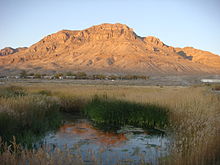In
geography, an
oasis (plural:
oases) or
cienega (
Southwestern United States) is an isolated area of vegetation in a
desert, typically surrounding a
spring or similar water source. Oases also provide habitat for animals and even humans if the area is big enough. The location of oases has been of critical importance for trade and transportation routes in desert areas. Caravans must travel via oases so that supplies of water and food can be replenished. Thus, political or military control of an oasis has in many cases meant control of trade on a particular route. For example, the oases of
Awjila,
Ghadames and
Kufra, situated in modern-day
Libya, have at various times been vital to both North-South and East-West
trade in the Sahara.
Oases are formed from underground rivers or aquifers such as an
artesian aquifer, where water can reach the surface naturally by pressure or by man made wells. Occasional brief thunderstorms provide subterranean water to sustain natural oases, such as the
Tuat. Substrata of impermeable rock and stone can trap water and retain it in pockets, or on long faulting subsurface ridges or volcanic dikes water can collect and percolate to the surface. Any incidence of water is then used by migrating birds who also pass seeds with their droppings which will.
Etymology
The word
oasis comes into English via
Latin:
oasis from
Ancient Greek:
ὄασις óasis, which in turn is a direct borrowing from
Demotic Egyptian. The word for
oasis in the later attested
Coptic language (the descendant of Demotic Egyptian) is
wahe or
ouahe which means a 'dwelling place'.
[1]
Growing plants
People who live in an oasis must manage land and water use carefully; fields must be irrigated to grow plants like
dates,
figs,
olives, and
apricots. The most important plant in an oasis is the date palm, which forms the upper layer. These palm trees provide shade for smaller trees like
peach trees, which form the middle layer. By growing plants in different layers, the farmers make best use of the soil and water. Many vegetables are also grown and some cereals, such as
wheat,
barley and
millet, are grown where there is more moisture.
[2]
Notable oases
Africa
- Nile River valley and delta, Egypt, is claimed as the world's biggest oasis by the 2007 edition of The Guinness Book of World Records with a stated area of 22,000 square kilometres.
- Bahariya Oasis, Egypt
- Dakhla Oasis, Egypt
- Farafra Oasis, Egypt
- Gaberoun, Libya
- Jalu, Libya
- Kharga Oasis, Egypt
- Kufra Oasis, Libya
- M'Zab Valley, Algeria
- Ouargla, Algeria
- Siwa Oasis, Egypt
- Tafilalt, Morocco
- Timimoun, Algeria
- Tozeur, Tunisia
- Tuat, Algeria
North America and South America
- Balmorhea State Park, United States
- Fish Springs National Wildlife Refuge, United States
- Huacachina, Peru
- La Cienega, New Mexico, a paraje on El Camino Real de Tierra Adentro, United States
- Las Vegas Valley, Nevada, United States, what was once an oasis in the vast Mojave desert has over the years grown into a metropolitan area.[3]
- Mulege, Baja California Sur, Mexico
- Post Park, United States
- San Ignacio, Baja California Sur, Mexico
- Twentynine Palms, California, United States
- Warm Springs Natural Area, United States
Asia
- Al-Hasa,The largest in Asia,[citation needed] Saudi Arabia.
- Al-Qatif, Saudi Arabia, large oasis on the coast of the Persian Gulf.
- Azraq, Jordan
- Ein Gedi, Israel
- Liwa Oasis, United Arab Emirates
- Loulan, China
- Miran, China
- Niya, China
- Tabas, Iran
- Turpan, China
- Yarkand, China
Australia






